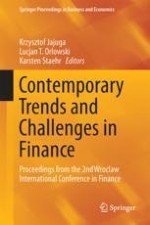2017 | OriginalPaper | Chapter
Determinants of the Spread Between POLONIA Rate and the Reference Rate: Dynamic Model Averaging Approach
Author : Paweł Kliber
Published in: Contemporary Trends and Challenges in Finance
Publisher: Springer International Publishing
Activate our intelligent search to find suitable subject content or patents.
Select sections of text to find matching patents with Artificial Intelligence. powered by
Select sections of text to find additional relevant content using AI-assisted search. powered by
